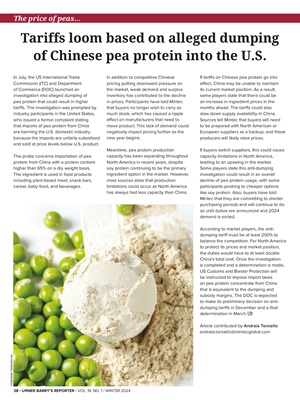
38 • URNER BARRY'S REPORTER / VOL. 19, NO. 1 / WINTER 2024
If tariffs on Chinese pea protein go into
effect, China may be unable to maintain
its current market position. As a result,
some players state that there could be
an increase in ingredient prices in the
months ahead. The tariffs could also
slow down supply availability in China.
Sources tell Mintec that buyers will need
to be prepared with North American or
European suppliers as a backup, and those
producers will likely raise prices.
If buyers switch suppliers, this could cause
capacity limitations in North America,
leading to an upswing in the market.
Some players state this anti-dumping
investigation could result in an overall
decline of pea protein usage, with some
participants pivoting to cheaper options
like soy protein. Also, buyers have told
Mintec that they are committing to shorter
purchasing periods and will continue to do
so until duties are announced and 2024
demand is sorted.
According to market players, the antidumping tariff must be at least 200% to
balance the competition. For North America
to protect its prices and market position,
the duties would have to at least double
China's total cost. Once the investigation
is completed and a determination is made,
US Customs and Border Protection will
be instructed to impose import taxes
on pea protein concentrate from China
that is equivalent to the dumping and
subsidy margins. The DOC is expected
to make its preliminary decision on antidumping tariffs in December and a final
determination in March.
Article contributed by Andraia Torsiello
andraia.torsiello@mintecglobal.com
In July, the US International Trade
Commission (ITC) and Department
of Commerce (DOC) launched an
investigation into alleged dumping of
pea protein that could result in higher
tariffs. The investigation was prompted by
industry participants in the United States,
who issued a formal complaint stating
that imports of pea protein from China
are harming the U.S. domestic industry
because the imports are unfairly subsidized
and sold at price levels below U.S. product.
The probe concerns importation of pea
protein from China with a protein content
higher than 65% on a dry weight basis.
The ingredient is used in food products
including plant-based meat, snack bars,
cereal, baby food, and beverages.
In addition to competitive Chinese
pricing putting downward pressure on
the market, weak demand and surplus
inventory has contributed to the decline
in prices. Participants have told Mintec
that buyers no longer wish to carry as
much stock, which has caused a ripple
effect on manufacturers that need to
move product. This lack of demand could
negatively impact pricing further as the
new year begins.
Meantime, pea protein production
capacity has been expanding throughout
North America in recent years, despite
soy protein continuing to be the primary
ingredient option in the market. However,
most sources state that production
limitations could occur as North America
has always had less capacity than China.
The price of peas…
Tariffs loom based on alleged dumping
of Chinese pea protein into the U.S.
©SrideeStudio / Shutterstock.com